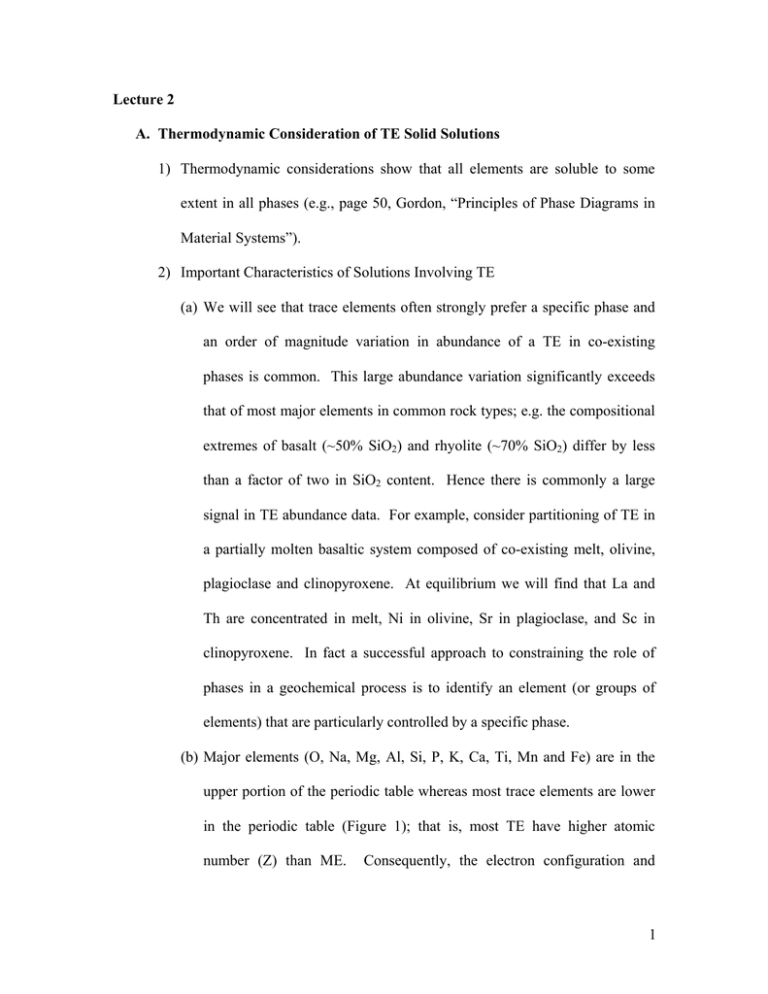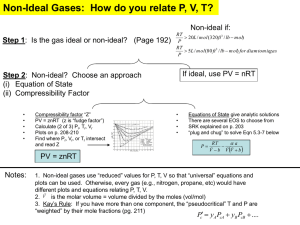Lecture 2 A. Thermodynamic Consideration of TE Solid Solutions
advertisement

Lecture 2 A. Thermodynamic Consideration of TE Solid Solutions 1) Thermodynamic considerations show that all elements are soluble to some extent in all phases (e.g., page 50, Gordon, “Principles of Phase Diagrams in Material Systems”). 2) Important Characteristics of Solutions Involving TE (a) We will see that trace elements often strongly prefer a specific phase and an order of magnitude variation in abundance of a TE in co-existing phases is common. This large abundance variation significantly exceeds that of most major elements in common rock types; e.g. the compositional extremes of basalt (~50% SiO2) and rhyolite (~70% SiO2) differ by less than a factor of two in SiO2 content. Hence there is commonly a large signal in TE abundance data. For example, consider partitioning of TE in a partially molten basaltic system composed of co-existing melt, olivine, plagioclase and clinopyroxene. At equilibrium we will find that La and Th are concentrated in melt, Ni in olivine, Sr in plagioclase, and Sc in clinopyroxene. In fact a successful approach to constraining the role of phases in a geochemical process is to identify an element (or groups of elements) that are particularly controlled by a specific phase. (b) Major elements (O, Na, Mg, Al, Si, P, K, Ca, Ti, Mn and Fe) are in the upper portion of the periodic table whereas most trace elements are lower in the periodic table (Figure 1); that is, most TE have higher atomic number (Z) than ME. Consequently, the electron configuration and 1 energy levels of electrons in ME and TE atoms are likely to be very different; for example, if we are considering Ni partitioning into forsterite, Mg2SiO4, the bonding between two Mg cations differs from that of Mg and Ni. Therefore we should expect that TE solutions are non-ideal. (c) Ideal Solutions: A solution is ideal if the chemical potential (u) of every component (i) is a linear function of the log of its mole fraction, (xi) i.e., o ui = u +RTln xi i o where ui = chemical potential at some standard state, R = gas constant T = temperature A definition of chemical potential (ui) is “A chemical potential is analogous to an electrical or gravitational potential in that by measuring the chemical potentials of components in different parts of the system, the tendency of material to flow or react can be deduced. The direction of flow of components is always from regions of high chemical potential to those of low chemical potential, so that the system as a whole approaches its lowest possible energy state.” (from Wood and Fraser, p. 8). Two characteristics of ideal behavior are: (1) ΔHmix = 0, i.e., no heat released upon mixing (2) Raoult’s Law is valid; i.e., a ij = x ij, where i = element, j = phase, xi = mole fraction, ai = activity, (see Figure 3). 2 1 Ideal (Raoult's Law) ai Non-ideal Henry's Law Behavior 0 0 xi 1 Figure by MIT OpenCourseWare. Figure 3. Activity (ai) versus mole fraction (Xi) of element i showing ideal solid solution ai = xi (Raoult’s Law), ai≠xi (non-ideal) and dilute solution behavior, i.e., the Henry’s Law region where a ij = k ijx ij as x ij → 0 j where ki is a constant, known as the Henry’s Law constant. (d) Non-ideal solutions A factor must be introduced to account for non-ideal behavior. It is γi, the activity coefficient, in the relationship a ij = γ ij x ij so that o o ui = ui +RTln a ij = ui + RTln γ ij x ij (see Figure 3 and p. 52 of Wood and Fraser) (note that γi is dependent on pressure, temperature, and phase composition). 3 (e) Dilute solutions, a special type of non-ideal behavior: By definition a trace element forms dilute solutions when Henry’s Law is obeyed, i.e. a ij = k ijxij, as xij → o , k ij the Henry’s Law Constant, is a constant as concentration of the TE approaches zero. It is the activity coefficient for species i in phase j at very low concentrations of “i”. j Henry’s Law essentially states that as xi → o , the non-ideal path can be described by a straight line with slope k (see Figure 3). However, as with all activity coefficients, Henry’s Law constants are a function of temperature, pressure, and phase compositions (e.g., ki will vary with changes in composition of solid solutions such as plagioclase (An-Ab) and olivine (FoFa). 4 MIT OpenCourseWare http://ocw.mit.edu 12.479 Trace-Element Geochemistry Spring 2013 For information about citing these materials or our Terms of Use, visit: http://ocw.mit.edu/terms.







